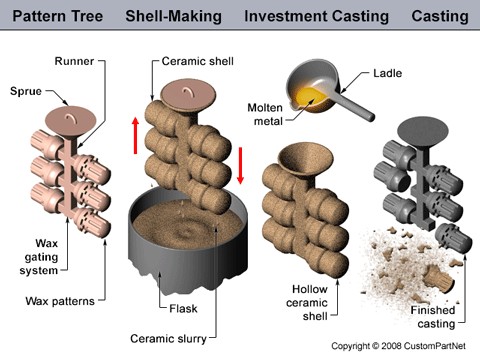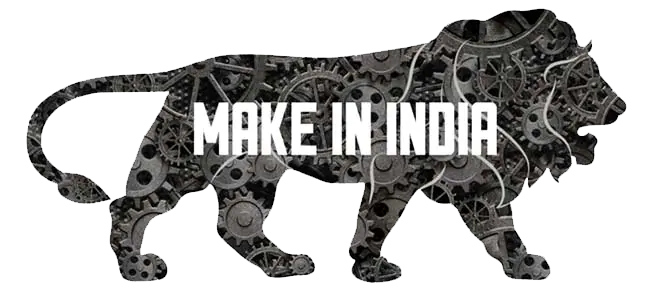Are you a newbie to manufacturing? Then, definitely you will get surprised at the word – Investment casting. However, this casting dates back to 5000 years. Manufacturers of those times used beeswax as the primary material. This blog acts as a valuable guide to investment casting materials. It also gives information on every material used in investment casting process.
What is Investment Casting?
Manufacturers use this process for producing accurate/complex shaped castings. The casting gets produced by the four-step process.
- The first material to get used is wax with a suitable pattern. It gets dipped into the slurry containing the refractory material.
- The refractory material gets hardened after some time. Then the dipping process continues. This is, until the coating becomes thick and it becomes strong.
- Then with heat treatment, the wax gets melted. Now molten metal gets poured into the shape (which has the refractory material).
- With time, the metal gets solidified. Then the refractory mould gets broken which results in the end product (cast).
Reference: custompartnet.com
Benefits of Investment Casting
A manufacturer can create custom manufacturing parts for any industry with this process. It can fit the needs of components of any size, shape as well as the materials.
Parts Manufactured from Investment Casting
- Gears
- Dental fixtures
- Jewellery Patterns
- Electronic components
Industries which need Investment Casting
- Aerospace industry
- Oil & Gas industry
- Automotive industry
- Power generation
- Security Industries
- Food Equipment
- & More.
Guide to Investment Casting Materials
1. Stainless Steel
This material has good durability and gets used in investment casting. Stainless steel gets used in manufacturing of automotive gears, golf club heads, and car gear box parts.
2. Steel Alloy
The chromium content in this investment casting material comes to 10.5 percent. It has a pleasing appearance and corrosion resistant properties. The steel alloy gets used in manufacturing of
- Agricultural equipment
- Ball valve components
- Poultry industry components
- Hinge assemblies.
3. Low Alloy Steel
The best part about low alloy steel is its affordability. Manufacturers give different types of heat treatments. The reason, this alloy can get moulded into parts with varying properties. The best example – in a single part, with heat treatment, one side can get corrosion resistant. The other part can become susceptible to wear and tear.
4. Aluminum Alloy
One of the preferred investment casting materials. This alloy gets used to manufacture airframe components of the aerospace industry. Sometimes, this alloy gets mixed with other materials (Si & Mg) to prepare components.
5. Carbon Steel
Considered a low cost material in comparison to its counterparts. Carbon steel comes in different grades as per the carbon content.
Heat treatment can make carbon steel get more ductility and strength. The best advantage is its ferro-magnetic properties. They make this alloy preferred in the automotive and electrical industries. Manufacturers use a combination of carbon steel with other alloys. This is to produce investment castings of
- Gun triggers
- Internal lock mechanisms
- Door Locks
- Hammers
- Critical parts of mining equipment
6. Super Alloys
We are referring to nickel and cobalt alloys. Nickel alloys get stronger when subjected to high temperatures. Cobalt based alloys have good corrosion, resistance-to-wear properties. They get used in investment casting to prepare components of
- Aerospace
- Marine Industry
- Chemical industries.
7. Copper Alloys
They have corrosion resistant properties as well low rates of wear and tear. The components prepared from these alloys are ship propellers, plumbing & electrical parts.
8. Cast Iron
The main constituents are ductile iron and gray iron. The advantages of cast iron are:
- Affordability
- High strength
- Toughness
- Heat resistance.
However, the investment casting process is complex. So the manufacturer has to invest more in producing a cast iron part.
The gray iron grades used are
- HT150
- HT200
- HT250
- HT300
- HT350
The ductile iron grades used are –
- QT400-15
- QT400-18
- QT450-10
- QT500-7
- QT600-9.
9. Cast Aluminum
Aluminium gets preferred over other materials because of its cost-effectiveness & durability. It is used in investment casting to prepare components of home appliances such as grinders and industrial machineries.
The grades used are
- A356
- ADC-12
- A380
- ZL104
10. Aluminum Alloy
When subjected to heat treatment, the alloy enhances its properties in terms of machinability, ductility and resistance to corrosion. In this process, it gets used to prepare valves, pistol frames, levels, heat sinks and others.
The industries which benefit are –
- Electrical industry
- Avionics industry
- Aerospace
11. Brass & Bronze
Both the alloys are non-sparkling and they do not have magnetic properties.
Both the alloys get used to manufacture
- Pump components
- Door handles
- Industry impellers.
12. Special Alloys
Some common special alloys used in investment casting are
- Duplex stainless 2205
- Monel
- Beryllium Copper
- Hastelloy
- Cobalt
- Chrome Cast Iron
- Nitronic® 50
- Tool Steel
These alloys get used in investment casting to prepare components for
- Aerospace
- Food & dairy
- Marine technology
- Oil & gas industry
- Fluid power industry
and more.
How to Get the Right Investment Casting Manufacturer for your Project?
Are you a buyer or sourcing professional who is busy searching on the internet to hire an investment casting manufacturer? Then, let us give you an easy option. Try searching on reputed custom manufacturing marketplaces. These digital platforms give a free option to enrol as a buyer. You can get industry leaders in the investment casting sector for your project. You can make use of the customised request for quotation and other software features. Then, you can get the right manufacturing partner to work on your project. On your part, ensure to select a company with the right credentials. They can manufacture with the right budget & supply high quality end products within the deadline.




